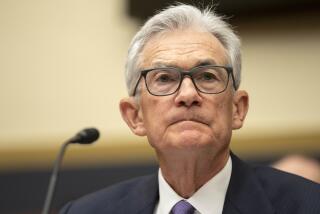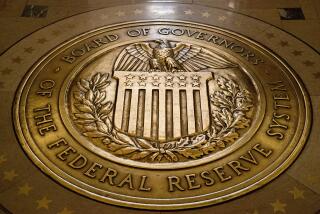Bernanke says Fed not on ‘preset course’ to reduce stimulus
- Share via
WASHINGTON -- Federal Reserve Chairman Ben S. Bernanke said Wednesday that he expected the central bank to start tapering its bond-buying stimulus program this year, but that there was not a “preset course” to doing so.
The Fed’s plan to begin reducing the purchases “in measured steps” still could change if the economic recovery does not continue to improve as the central bank projects, he said.
In testimony prepared for a congressional hearing, Bernanke also warned lawmakers that they could pose the biggest threat to an economic recovery that has been boosted by a rebounding housing market.
Tight fiscal policy, such as the large automatic spending cuts that kicked in on March 1, and the upcoming debate over raising the nation’s debt limit “could hamper the recovery” over the next few quarters, he said.
Bernanke reiterated earlier comments that the Fed’s monthly purchase of $85 billion in bonds would end around the middle of next year if the economy continues to improve.
But with financial markets jittery about when and how quickly the policy-making Federal Open Market Committee would start scaling back its easy-money policies, Bernanke cautioned that things could still change.
“I emphasize that, because our asset purchases depend on economic and financial developments; they are by no means on a preset course,” Bernanke said in comments he planned to deliver in his semi-annual report to the House Financial Services Committee on Wednesday morning.
In addition, Bernanke reiterated that the Fed plans to keep its short-term interest rate near zero for “a considerable time” after the bond purchases end, to continue stimulating the economy.
QUIZ: How much do you know about the federal budget cuts?
With so much attention on the Fed’s stimulus policies, Bernanke has a tough job in his testimony as he tries to provide investors with guidance while avoiding locking the central bank into policies that might not fit changing economic conditions.
The last time Bernanke testified on Capitol Hill, in late May, he triggered a 250-point swing in the Dow Jones industrial average as he made similar comments. Bernanke said at the time that the Fed could start scaling back its bond purchases in a few months, but then cautioned against acting too quickly.
He has been trying to refine his message ever since, and draw a clear distinction between slowing the bond purchases and continuing to keep short-term interest rates near zero until the unemployment rate falls to at least 6.5%.
The rate was 7.6% in June.
Bernanke tried to thread the same monetary policy needle in his prepared testimony Wednesday.
If the economy were to improve faster than expected and inflation appeared to be “rising decisively” toward the Fed’s 2% annual rate target, “the pace of asset purchases could be reduced somewhat more quickly,” he said.
But if the outlook for employment “were to become relatively less favorable,” inflation remained low and financial conditions continued their recent tightening, “the current pace of purchases could be maintained for longer,” he said.
Bernanke made a clear distinction between the bond purchases and the short-term interest rate, known as the federal funds rate. He noted the guidance about the rate is “the second tool the [ [Open Market] Committee is using to support the recovery.”
“The Committee has said it intends to maintain a high degree of monetary accommodation for a considerable time after the asset purchase program ends and the economic recovery strengthens,” he said.
ALSO:
Bank of America profit jumps 63% in second quarter
Senate confirms Richard Cordray as consumer bureau chief
Regulators propose $2.25-billion fine for PG&E in San Bruno explosion
More to Read
Inside the business of entertainment
The Wide Shot brings you news, analysis and insights on everything from streaming wars to production — and what it all means for the future.
You may occasionally receive promotional content from the Los Angeles Times.











